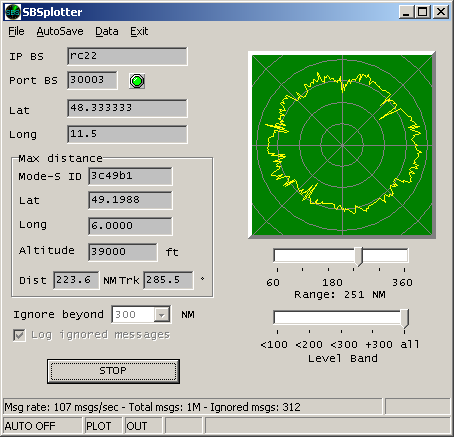Radarcape:Software Features
Because we are running a linux distribution … every thing is possible.
If you know the Mode-S Beast, you know it outputs the received data in a raw binary format. Decoding and interpreting of that data stream is a task of the GUI software that runs on the PC.
Now we have a quite powerful Linux based processor platform between the decoder (realized in the FPGA) and any form of user interface. That means that data streams similar to the Mode-S Beast can be generated, but the Radarcape can also generate Port 30003 format data, and it can generate aircraft lists that can be accessed by nothing more simple than a web browser. In similar way, with the software running under Linux, a KML/KMZ file can become generated that can be read directly by Google Earth®.
Due to the availability of nanosecond accurate timestamp, several Radarcapes can become coupled and can do multilateration without external computers.
The big advantage is that Linux is fully supported for the Beaglebone. There is no secret programming neither it is a properitary system. Application SW can be developed on a powerful Linux based PC, crosscompiled and run on the Beaglebone as well as it can compiled even on the Beaglebone itself (I'm using both ways). There is plenty of SW support for Linux, actually we are already using the Boost-Libraries and Google's libkml. Finally, Linux provides a complete ethernet stack, so networking is easy and powerful.
Radarcape Application Roadmap
Data Streaming to Network (TCP) / Prefiltering / Local CRC Check
The TCP streamed data will be prefiltered for CRC correctness of not directly CRC checkable frames. So the network load is lower than with the pure raw data stream. A port will be provided that streams out only DF-17 (and probably also DF-11) frames, so with least network load anyone else even behind a low speed network can have an overview of what's going around.
- TCP port 10002: This is a binary mirror of the data as it comes from the FPGA, DF-11, DF-17 and DF-18 are CRC-checked. Includes Mode-A/C data with respect to the setting in the FPGA (DIP switch).
- TCP port 10003: raw data with all Modes-S data formats CRC-prechecked (eleminiates transmission of the erroneous frames, reduces load on the transmission path). All data from the FPGA is disassembled into messages and verfied if correct. In case that, the frame is converted into the binary output format and transmitted over TCP. Includes Mode-A/C data with respect to the setting in the FPGA (DIP switch).
- TCP port 10004: pre-checked DF-11, DF-17 and DF-18 only: minimum load for the transmission path but contains most information. No Mode-A/C data.
- TCP port 10005: all raw data frames of just those aircraft that locally no location (latitude and longitude) is known. For special MLAT purposes. Includes Mode-A/C data with respect to the setting in the FPGA (DIP switch).
Port 30003 Server
Port 30003 style output can be provided standalone and without need of a PC application.
